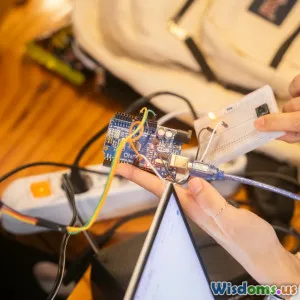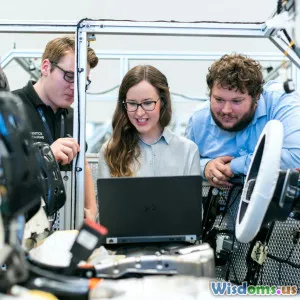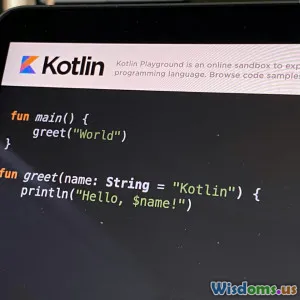
Unlock Reinforcement Learning Skills with These TensorFlow Tricks
9 min read Master reinforcement learning with TensorFlow tips to boost your AI projects and skills effectively. (0 Reviews)
Unlock Reinforcement Learning Skills with These TensorFlow Tricks
Reinforcement learning (RL) has emerged as a transformative technique powering breakthrough applications from game-playing AI to robotics and autonomous driving. Yet, mastering RL can be an intricate endeavor due to its complex algorithms, training instability, and computational demands. Enter TensorFlow—a versatile machine learning platform that has become a favorite toolkit among data scientists and researchers for streamlining the development and deployment of RL models.
In this article, we'll deeply explore how you can unlock and enhance your reinforcement learning skills leveraging TensorFlow's latest capabilities and best practices. From understanding the fundamental RL principles within TensorFlow frameworks, to mastering optimization tricks and practical coding patterns, you will gain actionable knowledge designed to accelerate your RL projects.
Understanding Reinforcement Learning and TensorFlow Integration
Reinforcement learning, fundamentally, is about training an agent to make a sequence of decisions by rewarding desirable behavior and punishing undesired ones. Unlike supervised learning, which learns from labeled data sets, RL agents learn strategies through interactions with an environment, optimizing long-term rewards.
TensorFlow offers both low-level APIs and high-level abstractions tailored to RL's unique needs:
- TensorFlow Agents (TF-Agents): A flexible library built on TensorFlow designed specifically for RL, providing modular components like environments, policies, networks, and learners.
- Keras integration for RL models: Allows building neural network policies with familiar high-level APIs.
These tools simplify handling complex RL workflows, such as agent-environment interaction loops, state representation learning, and reward processing.
Essential TensorFlow Tricks to Boost Reinforcement Learning Skills
1. Utilize TF-Agents for Rapid Prototyping
TF-Agents is Google's dedicated library for reinforcement learning that abstracts many boilerplate tasks. Its modular architecture lets you interchange policies, environments, neural network architectures, and sampling strategies effortlessly.
Example: To create a Deep Q-Network (DQN) agent in TF-Agents with minimal setup:
import tensorflow as tf
from tf_agents.agents.dqn import dqn_agent
from tf_agents.environments import suite_gym, tf_py_environment
from tf_agents.networks.q_network import QNetwork
from tf_agents.utils.common import function
# Load environment
env = suite_gym.load('CartPole-v0')
tf_env = tf_py_environment.TFPyEnvironment(env)
# Define Q-Network
q_net = QNetwork(
tf_env.observation_spec(),
tf_env.action_spec(),
fc_layer_params=(100,))
# Create DQN agent
optimizer = tf.keras.optimizers.Adam(learning_rate=1e-3)
agent = dqn_agent.DqnAgent(
tf_env.time_step_spec(),
tf_env.action_spec(),
q_network=q_net,
optimizer=optimizer,
td_errors_loss_fn=tf.keras.losses.Huber(),
train_step_counter=tf.Variable(0))
agent.initialize()
This snippet sets the stage for training an RL agent with minimal fuss.
2. Leverage TensorBoard for Real-Time Visualization
Training reinforcement learning models often involves tuning hyperparameters carefully. TensorBoard integration in TensorFlow allows you to visualize important metrics such as episode rewards, loss values, or policy entropy in real time, providing insights that guide iterative improvements.
train_summary_writer = tf.summary.create_file_writer('logs/train')
step = 0
with train_summary_writer.as_default():
tf.summary.scalar('episode_reward', reward, step=step)
This capability helps debug the training process and identify reward convergence or instability early.
3. Experiment with Custom Neural Network Architectures
TensorFlow’s flexibility with Keras model subclassing lets you tailor policy and value networks to problem-specific needs, beyond the standard feedforward designs.
For example, for environments with spatial data (like Atari games), convolutional layers improve feature extraction:
class ConvQNetwork(tf.keras.Model):
def __init__(self, action_spec):
super().__init__()
self.conv1 = tf.keras.layers.Conv2D(32, 8, strides=4, activation='relu')
self.conv2 = tf.keras.layers.Conv2D(64, 4, strides=2, activation='relu')
self.flatten = tf.keras.layers.Flatten()
self.dense = tf.keras.layers.Dense(512, activation='relu')
self.q_values = tf.keras.layers.Dense(action_spec.maximum + 1)
def call(self, inputs):
x = self.conv1(inputs)
x = self.conv2(x)
x = self.flatten(x)
x = self.dense(x)
return self.q_values(x)
Custom networks tailored to your environment intricacies lead to more efficient learning.
4. Memory Optimization with TF Datasets and Replay Buffers
Efficient experience replay significantly improves agent stability and performance. TensorFlow allows you to architect scalable replay buffers and pipeline experience data as tf.data.Dataset for optimal memory and training throughput.
The use of tf_agents.replay_buffers.TFUniformReplayBuffer integrates seamlessly with TensorFlow’s execution graph enabling accelerated mini-batch sampling:
from tf_agents.replay_buffers import TFUniformReplayBuffer
replay_buffer = TFUniformReplayBuffer(
data_spec=agent.collect_data_spec,
batch_size=tf_env.batch_size,
max_length=100000)
Efficient replay mechanics let your agent learn more from past behavior, reducing data redundancy.
5. Embrace Distributed Training for Complex Tasks
Scaling reinforcement learning across multiple GPUs or TPU cores can drastically cut training times for large-scale problems such as robotics simulations or high-dimensional environments.
TensorFlow's tf.distribute API supports distributing your RL training workload across multiple devices with minimal code changes:
strategy = tf.distribute.MirroredStrategy()
with strategy.scope():
# Build agent and optimizers here
agent = ...
agent.initialize()
Distributed TensorFlow enables parallel experience collection and synchronization of model parameters, unlocking accelerated experimentation.
Real-World Insights: TensorFlow-Powered Reinforcement Learning Success Stories
To emphasize the transformative power of TensorFlow in RL, consider DeepMind’s AlphaStar, a state-of-the-art AI that defeated professional StarCraft II players. While DeepMind used its proprietary tools, TensorFlow served as a core framework accelerant across their product lines.
Another example is OpenAI's Gym environments, widely used alongside TensorFlow for research and benchmarking. Numerous RL research papers cite TensorFlow implementations to replicate, improve, or extend baseline models.
Personal projects also thrive: from autonomous drone route planning to financial portfolio management, TensorFlow-enabled RL is democratizing the ability to experiment with these advanced models.
Final Thoughts: Your Next Steps to Master RL with TensorFlow
Unlocking reinforcement learning skills with TensorFlow is a highly rewarding journey blending foundational theory, practical experimentation, and iterative tuning. The tricks discussed—leveraging TF-Agents, customizing networks, utilizing TensorBoard, optimizing memory with replay buffers, and scaling with distributed training—form an essential toolkit every RL practitioner should master.
To continue climbing your RL learning curve:
- Engage actively with TensorFlow’s RL community forums and GitHub repositories.
- Contribute to or examine open-source RL projects leveraging TF-Agents.
- Tackle progressively challenging environments such as DeepMind Control Suite or MuJoCo simulations, deploying the TensorFlow innovations discussed.
With dedication and the right TensorFlow tricks, your reinforcement learning models won’t just learn — they’ll thrive.
References:
- TF-Agents Documentation: https://www.tensorflow.org/agents
- TensorFlow Distributed Training Guide: https://www.tensorflow.org/guide/distributed_training
- Sutton, R.S. & Barto, A.G. (2018). Reinforcement Learning: An Introduction.
- OpenAI Gym: https://gym.openai.com
Empower your AI capabilities today by diving into TensorFlow-powered reinforcement learning and watch your models evolve smarter and faster.
Rate the Post
User Reviews
Popular Posts

















